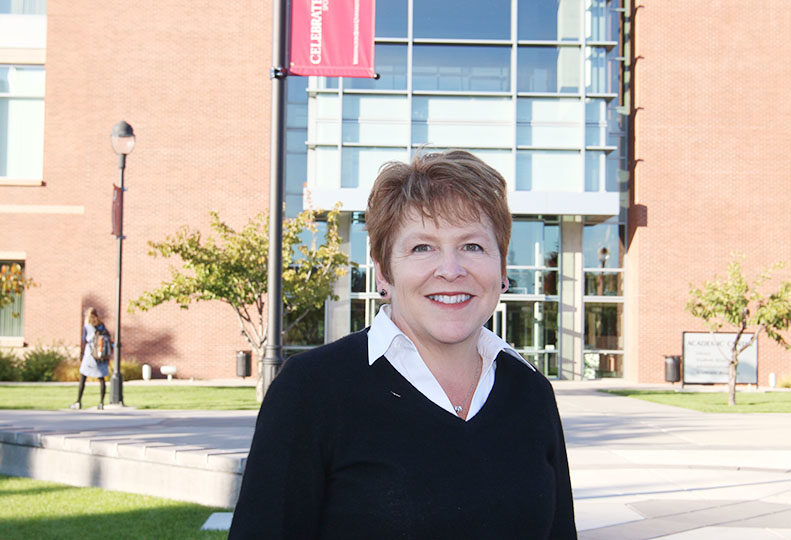
Home » Riverpoint Campus has room for two medical-school programs, Chancellor Brown says
Riverpoint Campus has room for two medical-school programs, Chancellor Brown says
UW separates WWAMI from WSU, plans to keep it here

October 23, 2014
This state, this town, and even the Riverpoint Campus is big enough for two university medical-school programs, contends Lisa Brown, chancellor at Washington State University Spokane.
Brown says there’s enough physical space in WSU Spokane’s Biomedical Sciences building and other facilities on the Riverpoint Campus to launch WSU’s envisioned four-year medical school and for UW to expand its WWAMI program.
WWAMI, which stands for Washington, Wyoming, Alaska and Idaho, is a UW School of Medicine regional medical education program. WWAMI’s long standing partnership with WSU here is breaking up, largely over WSU’s plans to launch its own fully accredited medical school.
“That was part of our proposal from the beginning,” she says of the concept of having two programs here, although WSU originally had envisioned partnering with UW in both programs. “The Spokane community had always talked about a four-year medical school being done in partnership with the University of Washington and WWAMI.”
While UW currently is looking for a new WWAMI partner, Brown says UW is welcome to continue to operate the program here in WSU facilities.
“We have enough capacity for 120 medical students per class,” she says. “I’m assuming as part of an agreement with UW, they would want to utilize that.”
As part of the dissolution, though, UW wants to run WWAMI without WSU’s faculty or administration, Brown says.
WSU plans to request $2.5 million during the next legislative session to proceed with the accreditation process for a full four-year medical school. WSU also will ask the Legislature to change a law that gives UW exclusive authority to operate a medical school through a state university in Washington.
As part of the accreditation process, WSU would hire a founding dean, establish a curriculum, and hire faculty to teach the curriculum.
“By 2017, we hope to start with a charter class of 40 students,” Brown says.
The WWAMI program in Spokane currently has 40 students per class, although UW proposes to expand that.
“If UW wants to expand, it’s possible there will be two requests in front of the Legislature,” Brown says.
Brown says WSU medical faculty would include physician teachers from the community. WSU also intends to train physicians in community hospitals, rather than construct an expensive university hospital, she says.
Dr. Henry Mroch, a Spokane physician and member of the Washington Alliance of Teaching Physicians, says the alliance supports a two-pronged approach that would involve a new medical school and expand WWAMI here to help address a statewide physician shortage.
He adds, however, “In terms of needing a second medical school in Washington, we’re more in support of that.”
The alliance is an ad hoc group made up of a few dozen mostly Spokane-area physicians. Most members have teaching positions with WWAMI or WSU Spokane, or both.
Mroch says neither university can eliminate the physician shortage by itself.
UW, for example, has seats for 120 in state medical students per year statewide, which is less than a third of the national average per state.
“We’re still going to be needing to graduate some 400 doctors per year in Washington,” Mroch says. “It’s going to be a number of years before both campuses can ramp up.”
He says he hasn’t heard from UW about how WWAMI is going to continue here without WSU.
“As far as the WWAMI dissolution goes, I don’t know what that’s going to mean for faculty,” he says. “Most all of the physician educators in town have clinical appointments through UW. Now we’re not sure how that stands.”
Norm Arkans, a Seattle-based UW spokesman, says the next step in dissolving the WWAMI partnership with WSU is to separate resources that currently support the WWAMI program here, including faculty.
“Some faculty are our employees, and some are WSU employees funded by WWAMI money,” he says. “That’s part of what needs to be separated.”
Arkans says UW’s goal is to complete the separation plan before the start of the 2015 legislative session.
WWAMI isn’t going to leave town, he says.
UW’s 2015-17 budget proposal includes a funding request to double the number of seats for students in the WWAMI program here.
Meantime, Arkans says UW hopes the breakup of the WWAMI partnership doesn’t affect how medical students view the program here.
“We continue to recruit students aggressively,” he says. “We think it’s a wonderful program in Spokane.”
While a new medical school would require approval and funding from the Legislature, Brown says she’s seen support for the concept of a second medical school from communities across the state, with the possible exception of the greater Seattle area.
“In King County, they might not see a problem,” she says. “King County has 29 percent of the (Washington state) population and 40 percent of the physicians. Outside of the Puget Sound area, there is widespread awareness of a physician shortage and difficulty accessing heath care.”
Latest News Education & Talent
Related Articles
Related Products


![Brad head shot[1] web](https://www.spokanejournal.com/ext/resources/2025/03/10/thumb/Brad-Head-Shot[1]_web.jpg?1741642753)

